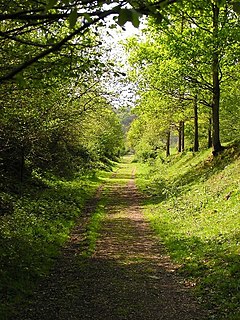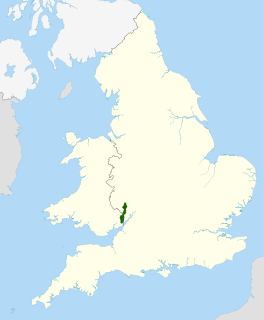
The Wye Valley Walk is a long distance footpath in Wales and England following the course of the River Wye.

The River Wye is the fourth-longest river in the UK, stretching some 250 kilometres from its source on Plynlimon in mid Wales to the Severn estuary. For much of its length the river forms part of the border between England and Wales. The Wye Valley is designated an Area of Outstanding Natural Beauty. The Wye is important for nature conservation and recreation but is severely impacted by pollution.

Tintern Abbey was founded on 9 May 1131 by Walter de Clare, Lord of Chepstow. It is situated adjacent to the village of Tintern in Monmouthshire, on the Welsh bank of the River Wye, which at this location forms the border between Monmouthshire in Wales and Gloucestershire in England. It was the first Cistercian foundation in Wales, and only the second in Britain.

Chepstow is a town and community in Monmouthshire, Wales, adjoining the border with Gloucestershire, England. It is located on the tidal River Wye, about 2 miles (3.2 km) above its confluence with the River Severn, and adjoining the western end of the Severn Bridge. It is 16 miles (26 km) east of Newport, 28 miles (45 km) east-northeast of Cardiff, 18 miles (29 km) northwest of Bristol and 110 miles (180 km) west of London.

Ross-on-Wye is a market town with a population of 10,582 according to the 2011 census, estimated at 11,309 in 2019. It lies in south-eastern Herefordshire, England, on the River Wye, and on the northern edge of the Forest of Dean.

Tintern is a village and community on the west bank of the River Wye in Monmouthshire, Wales, close to the border with England, about 5 miles (8.0 km) north of Chepstow. It is popular with tourists, in particular for the scenery and the ruined Tintern Abbey.

William Gilpin was an English artist, Anglican cleric, schoolmaster and author. He is best known as one of those who originated the idea of the picturesque.

Picturesque is an aesthetic ideal introduced into English cultural debate in 1782 by William Gilpin in Observations on the River Wye, and Several Parts of South Wales, etc. Relative Chiefly to Picturesque Beauty; made in the Summer of the Year 1770, a practical book which instructed England’s leisured travellers to examine “the face of a country by the rules of picturesque beauty”. Picturesque, along with the aesthetic and cultural strands of Gothic and Celticism, was a part of the emerging Romantic sensibility of the 18th century.

Lines Written a Few Miles above Tintern Abbey is a poem by William Wordsworth. The title, Lines Writtena Few Miles above Tintern Abbey, on Revisiting the Banks of the Wye during a Tour, July 13, 1798, is often abbreviated simply to Tintern Abbey, although that building does not appear within the poem. It was written by Wordsworth after a walking tour with his sister in this section of the Welsh Borders. The description of his encounters with the countryside on the banks of the River Wye grows into an outline of his general philosophy. There has been considerable debate about why evidence of the human presence in the landscape has been downplayed and in what way the poem fits within the 18th-century loco-descriptive genre.

Wales is an emerging tourist destination, with 8,078,900 visitors to National Trust and Wales Tourist Board destinations in 2002. As of 2017 the tourism industry in Wales has been estimated to have an annual turnover of £4.8 billion.

The Wye Valley Area of Outstanding Natural Beauty is an internationally important protected landscape straddling the border between England and Wales. It is one of the most dramatic and scenic landscapes in Britain.

The A466, also known as the Wye Valley Road, is a road from Hereford, England to Chepstow, Wales via Monmouth, Tintern and the Wye Valley.

Brockweir is a village in Hewelsfield and Brockweir civil parish, in the Forest of Dean District of Gloucestershire, England. The civil parish also includes the separate village of Hewelsfield.

The Wye Valley Railway was a standard gauge railway that ran for nearly 15 miles (24 km) along the Lower Wye Valley between the towns of Chepstow and Monmouth, crossing several times between Wales and England. Opened on 1 November 1876, it was leased to, and worked by, the Great Western Railway (GWR), before being fully absorbed by the GWR in 1905.

Lancaut is a deserted village in Gloucestershire, England, located alongside the River Wye, around two miles north of Chepstow. It occupies a narrow-necked promontory formed by a curve of the river, which acts as the border between England and Wales. Little remains of the village today, except for the roofless church of St. James.

Guide to the Lakes, more fully A Guide through the District of the Lakes, William Wordsworth's travellers' guidebook to England's Lake District, has been studied by scholars both for its relationship to his Romantic poetry and as an early influence on 19th-century geography. Originally written because Wordsworth needed money, the first version was published in 1810 as anonymous text in a collection of engravings. The work is now best known from its expanded and updated 1835 fifth edition.

The Doward, is an area in the parish of Whitchurch in south Herefordshire, England, consisting of the hills of Little Doward and Great Doward and extensive woodland. It is within the Wye Valley Area of Outstanding Natural Beauty, on the border with Monmouthshire, Wales. The area, about 3 miles (4.8 km) north-east of Monmouth, is shrouded in legend and King Arthur's Cave is in the vicinity.

The George Hotel, formerly The George Inn, is a public house and hotel in Chepstow, Monmouthshire, Wales. It is located next to the Chepstow Town Gate at the foot of Moor Street, and was once an important coaching inn. Although there has been an inn on the site since 1620, the current building dates from 1899.

Monmouthshire is a county and principal area of Wales. It borders Torfaen and Newport to the west; Herefordshire and Gloucestershire to the east; and Powys to the north. The largest town is Abergavenny, with other large towns comprising Chepstow, Monmouth, and Usk. The present county was formed under the Local Government (Wales) Act 1994, and comprises some sixty percent of the historic county. Between 1974 and 1996, the county was known by the ancient title of Gwent, recalling the medieval Welsh kingdom. The county is 850 km2 in extent, with a population of 93,600.

The Wyndcliff or Wynd Cliff is a steep limestone cliff rising above the western bank of the River Wye in Monmouthshire, Wales, some 1 mile (1.6 km) north-east of the village of St Arvans, 2.5 miles (4.0 km) south of Tintern, and 3.5 miles (5.6 km) north of the town of Chepstow, within the Wye Valley Area of Outstanding Natural Beauty. The cliff rises to 771 feet (235 m) at its summit, the highest point on the Monmouthshire bank of the Wye. The area is traversed by the Wye Valley Walk, and is also a popular venue for rock climbing. Access is provided by the A466 road which passes along the valley immediately below the cliff face.






















